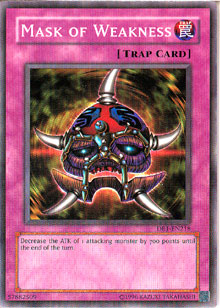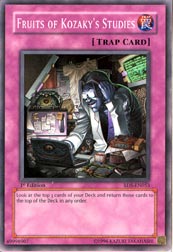In Part 1 of this series I wrote about the first two phases of my framework for testing against the expected metagame. This framework is a way to answer questions like: "What deck is good right now?" "How do I know a deck is good or not?" "How do I know what to use in my side deck?"
This week, we’ll wrap everything up with stage three.
Stage Three: Reflection, Further Testing, and Picking a Winner
Once you arrive at this stage, you’ll have done a lot of testing. Stage three is all about reflection on your previous work and forming conclusions about the validity of your deck. There are four questions that  need to be taken into consideration at this point:
need to be taken into consideration at this point:
1) What are my deck’s strengths?
2) What are my deck’s weaknesses?
3) How consistent were my hands?
4) Will this deck hold up in a 10-round Swiss tournament?
It’s important to know how your deck wins and why. Start with strengths. What does your deck do well? How are those things effective against other decks in the metagame? Is your deck an early game hotshot or a slow-starter? Concerning your weaknesses, they must be kept hidden from your opponent at all times. Knowing how well your deck actually compensates for its vulnerabilities is crucial. Can your opponent exploit those weaknesses with impunity or is it difficult? Do you know what decks are naturally good at exploiting your weaknesses (Think: Zombies vs. Macro Cosmos or Gladiators vs. Skill Drain)? Are your weaknesses obvious? Can your deck still win if a weakness is found and exploited? How can you minimize them?
Some decks are, by nature, much more resilient than others. This means that they are less affected by their shortcomings and are generally preferred over decks that have a hard time in the midst of a "hoser" (a single card or combo that ruins your particular strategy). Even if you find a weak spot in a powerhouse deck, it’s like trying to dig a hole through Mt. Everest with a pickaxe. A good example from dueling history is the early dominance and immense strength of Dark Armed Return. It took an entirely new archetype (Gladiator Beasts) to take it down. The recent success of Gladiators is caused by the enormous strength and speed of the Dark Armed decks. Since the Dragon beat everything at the time, Gladiators were able to flourish because it was the only deck that dismantled Dark Armed. There are some decks that pop up here and there, but this trend has held true for a few events now. Trends like these are important to take into consideration. Coming up with a deck that beats both Dark Armed Dragon and Gladiator Beasts is a very tall order.
In long tournaments, hand strength and consistency are king. Your concept might be a smashing idea, but if you can’t bring it to the table when you need it, it’s useless. That’s why, to me, it’s vital that you know how consistent your hands are mathematically. When you do your testing, take a moment to note the frequency of playable hands vs. non-playable hands. Record how changes to the deck affect this ratio. How often does your deck accomplish what it was built to do? How many wins were achieved as a result of your deck hitting its key plays?
After all this introspection and analysis, you can answer question four. It’s a simple yes or no question, and you need to be honest. If the answer is
"no," then ask yourself "why?" Even if the answer is "yes" you should still ask why. What is it about this deck that makes you so confident? Write it down if you have to, but the point of this question is to establish clarity. You’ll need this clarity when you come up against discouraging matches on tournament day.
Speaking of tournament day . . . the ultimate test of your ideas is to take your deck to some sanctioned tournaments before the main event you’re testing for. Nothing prepares you better for the "big day" than live tournament practice. Sign up for a few locals and regional qualifiers to get your feet wet. At these tournaments, you can find out if there are any new strategies out there that you haven’t heard about. Sometimes they creep up at the last minute, but you shouldn’t panic. Find out what the deck is all about and pay attention. If you have to watch those matches like a hawk, do so. Take notes and then take what you’ve seen and put it to the test at home with your testing group. Does it present so great a threat that you are required to side for it? What are the odds of this strategy popping up on game day? Is this being discussed heavily by your usual sources or the public? This is where having eyes and ears—your network—is important.
Now, we have to put this all together. You’ve done your preliminary research in stage one. You’ve done your rigorous testing in stage two. In stage three, you’ve done a lot of reflection and maybe a bit more testing. Sometimes even after this difficult process you’ll have two  decks that measure up to the difficult standards you’ve set. At this point, it’s appropriate to ask: which deck is the winner? You can ask a lot of players how they choose between deck A and deck B, but you’ll get a hodge-podge of responses. I think this situation is rare, especially after several rounds of testing. When it does come up, I think I have a solution for you: pick the deck that you’re most comfortable with. You already know that both decks perform very well against the field. Some are easier to pilot than others and some are more familiar. I personally believe that all players have an innate inclination to certain types of decks. Maybe a super-aggressive deck strategy isn’t as "comfortable" for you to play as a slower control style? I know this sounds very subjective, but I’d rather play with something that won’t leave me open to mistakes of any kind. I think that comfort and familiarity with a deck helps prevent unnecessary mishaps. I suggest that this "comfort" test only be applied if you’ve already completed your three-stage process. Applying the "comfort" rule before you even do any testing is a fast track to nowhere, and you have no idea how long it took me to learn that vitally important lesson.
decks that measure up to the difficult standards you’ve set. At this point, it’s appropriate to ask: which deck is the winner? You can ask a lot of players how they choose between deck A and deck B, but you’ll get a hodge-podge of responses. I think this situation is rare, especially after several rounds of testing. When it does come up, I think I have a solution for you: pick the deck that you’re most comfortable with. You already know that both decks perform very well against the field. Some are easier to pilot than others and some are more familiar. I personally believe that all players have an innate inclination to certain types of decks. Maybe a super-aggressive deck strategy isn’t as "comfortable" for you to play as a slower control style? I know this sounds very subjective, but I’d rather play with something that won’t leave me open to mistakes of any kind. I think that comfort and familiarity with a deck helps prevent unnecessary mishaps. I suggest that this "comfort" test only be applied if you’ve already completed your three-stage process. Applying the "comfort" rule before you even do any testing is a fast track to nowhere, and you have no idea how long it took me to learn that vitally important lesson.
Final Thoughts
I’ll repeat what I said last week: I’m confident that this framework is a great starting point to producing the results you want. If you’re looking for success in high-level play, then you need to remember a few points. First, this is not easy. It often takes hard work to produce stellar results. One of the reasons why hard work often produces great results is because so few are willing to actually do it. Second, winning major tournaments has almost nothing to do with luck. Third, what others think of your skill level is entirely irrelevant. You don’t need everyone to tell you how great you are. Most of the time, they won’t. Trust me on this one.
Lastly, tournaments are not a test of your self esteem or your worth. If you don’t win a tournament, don’t start thinking that something is wrong with you or the game. That self-doubt is entirely irrelevant because it’s only a game. It’s one that you and I enjoy very much, but it’s still a game. What’s relevant is your own objective measure of yourself and your abilities. There are plenty of expert players who scrub out like any other newbie, but they keep at it because they know they’re good.
Until next time, stay focused and have fun!
—Bryan Camareno